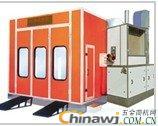First, the technical configuration of the high-temperature baking room:
1. The outer dimensions are 6500×2500×2500 mm (L×W×H), while the inner dimensions are 6350×2350×2350 mm (L×W×H). This ensures sufficient space for operations and efficient heat distribution.
2. The front door is equipped with two fans measuring 1000×2000 mm (W×H). The door frame is made from special aluminum alloy, and the edges are sealed with high-temperature resistant rubber strips to prevent heat loss and ensure airtightness.
3. The wall panels are constructed using high-temperature rock wool boards with a thickness of 75 mm. The color of the panels matches the overall design for aesthetic consistency.
4. The heating system consists of one set with 60 infrared carbon fiber heating tubes, each rated at 1000W. This provides a maximum heat output of 6,000,000 kcal/h, with a temperature range from 80°C to 230°C.
5. The top panel is made of high-temperature resistant rock wool board with a thickness of 75 mm, formed under pressure. The roof beam skeleton is made from standard square tubes measuring 4×8 mm.
6. The electronic control system includes paint controls, a temperature controller, lighting switches, fault indicators, power switches, emergency stop buttons, and time-of-flight functions—all standard components for safe and efficient operation.
7. The voltage is 380V at a frequency of 50Hz, ensuring stable power supply.
8. The total power consumption is 60kW, making it energy-efficient for continuous use.
9. The base also uses high-temperature rock wool boards with a thickness of 75 mm, providing insulation and structural stability.
Second, when using a high-temperature paint booth, it's important to follow specific temperature standards. Here are five key requirements:
1. When the high-temperature paint booth is in operation, the fan circulates hot air. The baking temperature ranges from ambient to 600°C, and both temperature and time can be adjusted (up to 2 hours) with automatic control. The air circulation system is fully integrated, featuring powerful fans that ensure fast airflow and prevent paint mist buildup, which improves operator safety and painting quality.
2. The electrical control system consists of a control cabinet and pipeline racks, designed for easy maintenance and operation.
3. It supports automatic control of power supply, temperature regulation, and baking time, enhancing efficiency and reducing manual intervention.
4. The control panel features meters for current and voltage, a digital temperature display, a temperature controller, a time controller for high-temperature painting, and buttons for the fan, heater, and lighting.
5. All electrical equipment is interlocked for added safety, preventing accidental operation and ensuring compliance with safety standards.
The development of modern paint booths has led to unexpected applications. High-temperature paint booths are commonly used for automotive and furniture painting. Some people have even found creative uses—like growing crops inside them. In winter, technicians in a certain area repurposed an idle high-temperature paint booth for crop cultivation, aiming to make the most of unused facilities.
After noticing the long period of inactivity, local farmers saw potential. They said, “Growing plants often requires higher temperatures than outside, and the cost is significant. Using this facility can save a lot.†With support from the County Agriculture and Animal Husbandry Bureau, they received technical guidance. Technicians visited regularly to monitor plant growth.
It was unusual to see crops grown in a high-temperature paint booth. However, the structure remained unchanged, and only an automatic humidification spray system was added. This innovative approach not only saved costs but also increased income, showing how versatile these spaces can be.

Solar Panel
Solar panels capture the sun's energy and convert it into electricity. A typical solar panel is made up of individual solar cells, which are up of layers of silicon, boron, and phosphorus. The boron layer provides the positive charge, the phosphorus layer provides the negative charge, and the wafers act as semiconductors. When photons from the sun hit the surface of the panel, they knock electrons free from the silicon and into the field generated by the solar cell. This creates a directional current that can then be converted into usable power. The whole process is known as the photovoltaic effect A standard solar panel has 36, 60, 72, or 90 individual solar cells.
Solar Panel,Solar Panels,Solar Panel Cost
Jiangsu chuanglv Transportation Facilities Co., Ltd , https://www.clsolarlights.com
